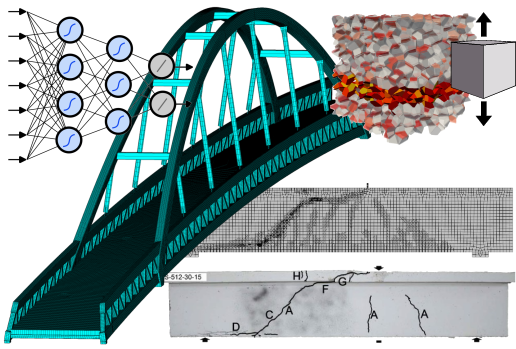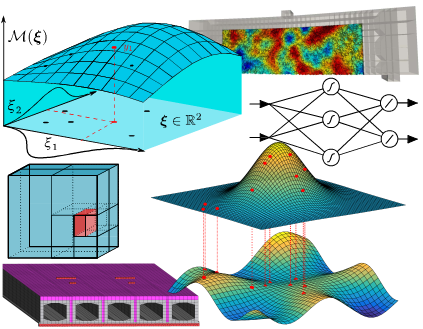Welcome to the Institute of Structural Mechanics (ISM)
The Institute of Structural Mechanics (ISM) provides students with professional and research skills especially in topics of stress and deformation/strain analyses, and structural failure processes. Our staff is deeply involved in scientific research activity covering wide spectrum of practical and theoretical topics.
Computational mechanics of materials and structures

Our research activities encompass both fundamental and applied studies on numerical methods for analyzing the mechanical and multiphysical behavior of various physical systems. Our focus ranges from mesoscale modeling of heterogeneous materials to large-scale structural simulations of bridges and power plants. We address both steady-state and transient phenomena in solids and fluids. Our primary research interests include:
- numerical simulation of crack initiation and propagation in quasi-brittle materials such as concrete and ceramics using linear elastic fracture mechanics, cohesive zone models, crack band models, discrete mesoscale models, and related techniques;
- simulations of fatigue deterioration and fatigue crack propagation in homogeneour and heterogeneous materials, high- and low-cycle fatigue;
- homogenization of heterogeneous structures exhibiting inelastic behavior;
- application of machine learning in mechanics, such as automated identification of material parameters and AI-based surrogate modeling of substructure responses;
- analysis of slender structures, including buckling and numerical simulations of stability loss;
- behavior of dissipative nonlinear dynamical systems, including chaotic phenomena and the fractal dimension of fracture surfaces and crack patterns;
- computational fluid dynamics and fluid–structure interaction;
- numerical methods for textile membrane structures, including form-finding and the theory of suspension and cable-supported structures;
- applied research and industrial collaborations for the design and assessment of real-world engineering structures;
- analysis of structural degradation, advanced methods for the assessment of load capacity, damage identification using vibration response;
- development of custom software, whether open-source or proprietary, for mechanical and multiphysical simulations.
Reliability of structures and systems

Our team is dedicated to the development of methodologies that utilize computer models of physical phenomena to study the propagation of uncertainties and imprecisions in input variables through complex transformations. Our work includes input screening, parameter optimization, sensitivity and statistical analyses, and reliability assessments aimed at quantifying the probabilities of rare events. The models we analyze are typically highly computationally demanding. In addition to designing optimal one-shot computer experiments, we also develop adaptively augmented point designs. The overarching goal is to deepen the understanding of how uncertainty propagates from input data to model outcomes. Our core research activities include:
- systematic development of methods for probabilistic design of concrete structures throughout their life cycle, based on stochastic nonlinear computational mechanics;
- probabilistic aspects of fatigue failure of heterogeneous materials (this topic was awarded by prestigious ERC grant);
- development of surrogate metamodels, including physics-informed polynomial chaos expansions, artificial neural networks, nearest neighbor approaches, kriging, and radial basis functions;
- uncertainty quantification of mathematical models, including estimation of probability distribution of quantity of interest;
- global sensitivity analysis, with a focus on quantifying additive and interaction effects in stochastic computational models in structural mechanics;
- solution of inverse problems across the life cycle of engineering structures by combining classical techniques with machine learning methods;
- investigation of statistical size effects, spatial variability of material properties, and the interplay between mechanics and probability theory;
- design of experiments, one-shot desing and adaptive sequential designs, including optimal sampling in design spaces using Monte Carlo methods, quasi-Monte Carlo sequences, Latin hypercube sampling, stratified sampling, asymptotic sampling, and subset simulation;
- dimensionality reduction techniques, both linear and nonlinear;
- development of custom software, either open-source or proprietary, for probability-related tasks.



